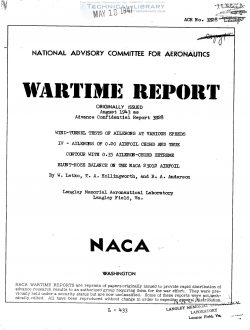naca-wr-l-433
- Version
- 177 Downloads
- 1.61 MB File Size
- 1 File Count
- April 3, 2017 Create Date
- April 3, 2017 Last Updated
Wind Tunnel Tests of Ailerons at Various Speeds - IV - Ailerons of 0.20 Airfoil Chord and True Contour with 0.35 Aileron-Chord Extreme Blunt Nose Balance on the NACA 23012 Airfoil

Tests were made on an EACA 23012 airfoil fitted with a
20-percent—chord, true—contour aileron with 35-porcent-
chord, extreme bluntmnoee balance. The tests were made
in the two—dimensional test section of the NADA stability
tunnel at a range of aircpeeds from 160 to 360 miles per
hour, which corresponded to a range of hach numbers frOm
0.195 to 0.475. The primary purpose of the investigation
was to determine the variation of the aerodynamic character-
istics of this type of aileron with airspeed; the effect of
variations of gap width and balance—nose radii was also in—
vestigated.
The results of the-investigation are presented as curves
of section hinge—moment coefficient and section lift coeffi—
cient plotted against aileron angle, and cross plots have been
made to illustrate the effect of variations of Mach number'
balance—nose radii, and gap width on the aerodynamic charac—
teristics of the aileron. For small aileron deflections at
low angles of attack, increased airspeed had little effect
on the rate of change of section hinge—moment coefficient
with aileron deflection but increased the rate of change of
section lift coefficient with aileron deflection. Increased
airspeed decreased the'unstalled range.of the-aileron and
increased the rate of—change of section lift coefficient and
section pitching moment coefficient with angle of attack. An
increase in gap width at low angles of attack for small aile—
ron deflections decreased the rate of change of section lift
coefficient with aileron deflection and appreciably decreased
the rate.of change of section hinge-moment coefficient with
aileron deflection. Increased balance—nose radii increased
the rate of change of section hinge—moment coefficient with
aileron deflection for small aileron deflections and appre—
oiably increased the unstalled range of the aileron.
INTRODUCTION
The recent trend in airplane design toward increased
size, power, and radius of gyration in roll and the demand
for greater maneuverability at high airspeeds have made
necessary almost perfectly balanced controls on combat air—
craft with no decrease in control effectiveness. Although
most present aileron installations are fairly satisfactory
at low airspeeds, these installations may be unsatisfactory
at high airspeeds because of insufficient balance and, in
some cases, overbalance. In an effort to overcome this
difficulty, the Rice has undertaken a series of investiga—
tions to determine the aerodynamic characteristics of various
types of balanced control surfaces at higher airspeeds than
were used in their deve10pment. The results of similar tests
have been reported in references 1, 2, and 3.
The present report contains the results of tests of a
20—percent—chord aileron with a 35—percent—chcrd extreme
blunt nose balance on an NAGA 23012 airfoil; the aileron
was similar to that of reference 1 with the exception of the
airfoil section contour, A 0.35—aileron—chord balance was
chosen because the results of reference 4 obtained at low
airspeeds indicated that this aileron would give almost com—
lete balance at a low angle of attack.
| File | Action |
|---|---|
| naca-wr-l-433 Wind Tunnel Tests of Ailerons at Various Speeds - IV - Ailerons of 0.20 Airfoil Chord and True Contour with 0.35 Aileron-Chord Extreme Blunt Nose Balance on the NACA 23012 Airfoil.pdf | Download |

Comment On This Post